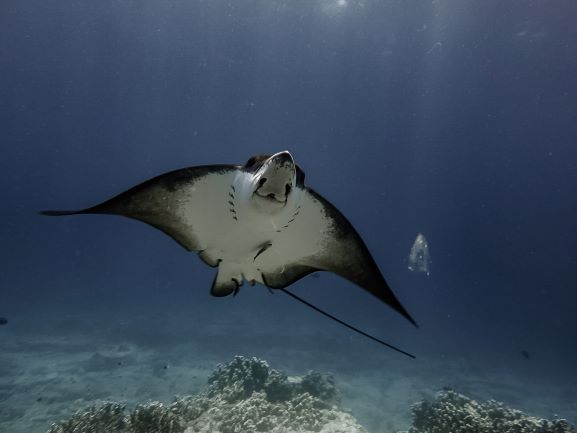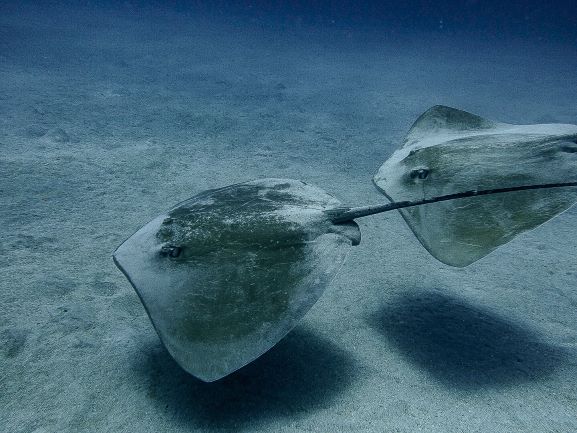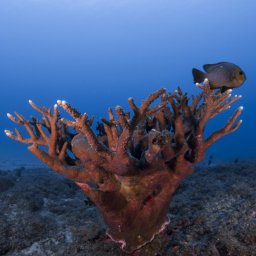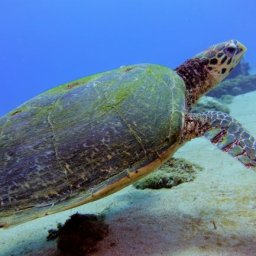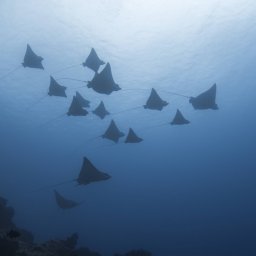Skates
Skates are the most diverse group of cartilaginous fish, comprising over 20% of all known batoids. They are commonly found along continental shelves and upper slopes down to depths of 3000 meters, and are typically more diverse in deeper water and at higher latitudes. In fact, skates are the only cartilaginous fish group to exhibit more species diversity at higher latitudes.
Distinguishing Characteristics
Skates have flat pectoral fins that extend the length of their body and have ventral gill slits like their cousins. Skates also have dorsal spiracles that allow them to breathe while remaining partially buried beneath the sea floor. In addition to their pectoral fin, skates have a first and second dorsal fin, caudal fin, and pelvic fins. Their fleshy, slender tail is a stark difference from their rhomboidal shape.
Skates are bottom feeders, preying on shrimp, crabs, oysters, clams, and other invertebrates, using grinding plates in their mouths to crush hard shells and exoskeletons.
Skates use the Rajiform locomotion we discussed previously. This form of movement is being explored as a possible origin for our own walking technique. Scientists are looking for similar neural pathways used for movement between skates and animals walking on land.
Similar to how turtles return to the same beach to lay their eggs, skates mate at the same nursery grounds each year. One of the things that makes a skate different from a ray is that a skate lays eggs while a ray gives live birth. Skates lay their eggs in a case commonly called a mermaid’s purse. These egg cases have distinct characteristics that are specific to individual skate species, making it easier to identify them.
Stingrays
Stingrays have had a bad reputation ever since a short-tailed stingray, Dasyatis brevicaudata, fatally injured Steve Irwin in 2006, and are now often considered dangerous. The truth is that stingrays are quite docile, even a bit shy, and some species can be very friendly if you remain calm and are a bit lucky. There are approximately 220 known stingray species, which are commonly found in coastal and subtropical waters throughout the ocean.
Stingrays only attack when they feel threatened. Most of the time the attack is caused by an unsuspecting swimmer stepping on their tail. Stingrays live and hunt in shallow, sandy areas, like the beaches and shores commonly visited by divers and other tourists. Remember to shuffle your feet along the bottom if you enter an area where stingrays may live. This warns stingrays that you are there, and gives them a chance to move out of your way. Stingrays generally do not attack If they feel threatened—their main defense is to swim away. However, a defensive reaction causes the animal to whip its tail, which is how you could be injured. Stingray barbs are rarely fatal and usually result in a cut, pain, and swelling.
Distinguishing Characteristics
Stingrays exhibit a wide range of colors and patterns and can even change color over the course of several days to blend into new surroundings. One of the unique characteristics of stingrays is their jaw configuration. Their upper jaw is not fused to the cranium. Instead, it articulates with the lower jaw. This is an evolutionary trait that helps them capture prey.
Stingrays are ovoviviparous, and bear live young once a year on average in litters of five to thirteen pups. The females hold the embryos in the womb without a placenta. The embryos instead absorb nutrients through a yolk sac. During this time, the female’s behavior changes to support her future offspring. After birth, some stingray mothers protect their young until they are able to defend themselves or are physically mature, which can take up to three years.
Stingrays employ a wide variety of feeding strategies. The carnivorous species have large, flat teeth used for crushing hard shells and exoskeletons of their prey, like mollusks and crustaceans. Others use external mouth structures called cephalic lobes to guide plankton into their mouths.
Eagle Rays
There are about two dozen species of eagle ray in the family Myliobatidae. Many tourists are particularly fond of the spotted eagle ray, Aetobatus narinari. This ray is often considered the most beautiful eagle ray and can be easily identified by star-like white spots covering its inky blue body.
Eagle rays are found throughout the world’s temperate seas, typically in shallow coastal waters down to about 76 meters. They will often enter sheltered bays to feed or mate. Considered a coastal species, their worldwide distribution implies that some individuals may migrate great distances. It is possible that future genetic research will reveal that eagle rays in different ocean basins are in fact distinct species.
Distinguishing Characteristics
Eagle rays have rhomboidal bodies that are often much wider than they are long. Their pectoral fins are enlarged and wing-like and they have rounded teeth to aid them in crushing mollusks and crustaceans. They possess a very long, well-defined tail that can be longer than its entire body!
Spotted eagle rays, Aetobatus narinari, can reach up to five meters in length. They have a fin-span of three meters and weigh over 230 kilograms. With their specialized chevron-shaped teeth they are able to crush the hard shells of mollusks and crustaceans. As well, they have been known to also eat crabs, bivalves and other benthic invertebrates.
Like their stingray cousins, eagle rays are ovoviviparous and reproduce via internal fertilization before giving live birth. They usually have between one and four embryos, which live off of energy obtained from yolk sacs. Only when the pups are old enough to survive on their own does the mother give birth. This low reproductive potential is one of the reasons, that to scientists classify some eagle ray species as ‘near threatened’ to extinction.
While eagle rays are not directly targeted by commercial fisheries, they are often caught and killed as bycatch.

